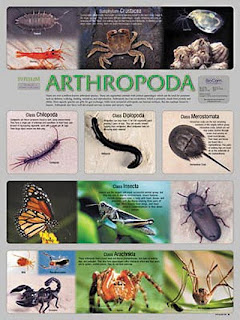Arthropods (in Latin, Arthra = vertebra, books, segment; podos = foot) is characteristic of animals that have segmented legs and segmented. Segments are also found on his body. Arthropod body is bilateral and relatively tripoblastik selomata.
Characteristic body
Arthropod body traits include size, shape, structure, and function of the body.
The size and shape of the body
Arthropod body size is very diverse, some of which have a length of more than 60 cm. , But most are small. Similarly, the form of arthropods were varied.
Body structure
Arthropods segmented body with varying number of segments. At each body segment was there a pair of segmented legs. Segments combine to form part of the body, which is Kaput (head), thorax (chest) and abdominal (stomach). Another feature of arthropods is the presence of hard cuticle that forms the framework of the outside (exoskeleton). Exoskeleton made of chitin in excretion by skin cells. Exoskeletons attached to the skin to form a strong body protection. Exoskeleton consists of plates which are connected by flexible ligaments and soft. Exoskeleton can not grow following the growth of the body. Therefore, the growth stage is always followed by an exfoliation Arthropods old exoskeleton and forming a new exoskeleton. Release phase is called molting exoskeleton or ekdisis. Animals that normally do ekdisis eg crab, shrimp, and spiders. Arthropods nervous system in the form of a rope ladder nervous system amounted to a pair that is along the ventral side of his body. At various places on the body segments, there is enlargement of nerves called ganglia rope ladder. Ganglia serves as a central reflex and control of various activities. Ganglia of the anterior part of a larger function as the brain. Arthropods digestive system consists of the mouth, esophagus, stomach, intestine, and anus. Equipped mouth with a diverse range of additional tools, such as the mandible and maxilla in grasshoppers. Arthropods breathe with gills, trachea, or lungs books. Metabolic waste liquid form issued by the organs of excretion-called channel / Malpighi tubules, gland excretion, or both. Arthropods are open circulatory system. Circulatory system consists of the heart, blood vessels shorter, and the space around the organs called the sinus or hemosol. Arthropods also called hemolimfa blood.
Way of life and habitat
Arthropods are very diverse ways of life, there are free-living, parasitic, commensal, or symbiotic. Our environment, often encountered this group of animals, such as mosquitoes, flies, ants, butterflies, dragonflies, grasshoppers, and bees. Habitat is very wide spread of Arthropods. There are at sea, freshwater, deserts, and grasslands.
Reproduction
Arthropods reproductive system generally occurs sexually. But there is also an asexually, by parthenogenesis. Parthenogenesis is the formation of a new individual without fertilization (conception). The resulting individual is sterile. Male and female reproductive organs on separate arthropods, each of which produces gametes in individuals who are different that are dioseus (married two). The results of egg fertilization.
Characteristic body
Arthropod body traits include size, shape, structure, and function of the body.
The size and shape of the body
Arthropod body size is very diverse, some of which have a length of more than 60 cm. , But most are small. Similarly, the form of arthropods were varied.
Body structure
Arthropods segmented body with varying number of segments. At each body segment was there a pair of segmented legs. Segments combine to form part of the body, which is Kaput (head), thorax (chest) and abdominal (stomach). Another feature of arthropods is the presence of hard cuticle that forms the framework of the outside (exoskeleton). Exoskeleton made of chitin in excretion by skin cells. Exoskeletons attached to the skin to form a strong body protection. Exoskeleton consists of plates which are connected by flexible ligaments and soft. Exoskeleton can not grow following the growth of the body. Therefore, the growth stage is always followed by an exfoliation Arthropods old exoskeleton and forming a new exoskeleton. Release phase is called molting exoskeleton or ekdisis. Animals that normally do ekdisis eg crab, shrimp, and spiders. Arthropods nervous system in the form of a rope ladder nervous system amounted to a pair that is along the ventral side of his body. At various places on the body segments, there is enlargement of nerves called ganglia rope ladder. Ganglia serves as a central reflex and control of various activities. Ganglia of the anterior part of a larger function as the brain. Arthropods digestive system consists of the mouth, esophagus, stomach, intestine, and anus. Equipped mouth with a diverse range of additional tools, such as the mandible and maxilla in grasshoppers. Arthropods breathe with gills, trachea, or lungs books. Metabolic waste liquid form issued by the organs of excretion-called channel / Malpighi tubules, gland excretion, or both. Arthropods are open circulatory system. Circulatory system consists of the heart, blood vessels shorter, and the space around the organs called the sinus or hemosol. Arthropods also called hemolimfa blood.
Way of life and habitat
Arthropods are very diverse ways of life, there are free-living, parasitic, commensal, or symbiotic. Our environment, often encountered this group of animals, such as mosquitoes, flies, ants, butterflies, dragonflies, grasshoppers, and bees. Habitat is very wide spread of Arthropods. There are at sea, freshwater, deserts, and grasslands.
Reproduction
Arthropods reproductive system generally occurs sexually. But there is also an asexually, by parthenogenesis. Parthenogenesis is the formation of a new individual without fertilization (conception). The resulting individual is sterile. Male and female reproductive organs on separate arthropods, each of which produces gametes in individuals who are different that are dioseus (married two). The results of egg fertilization.

No comments:
Post a Comment